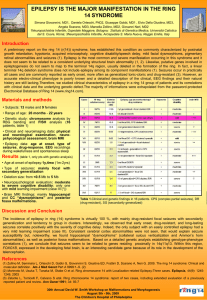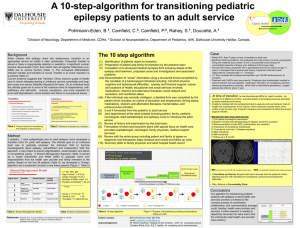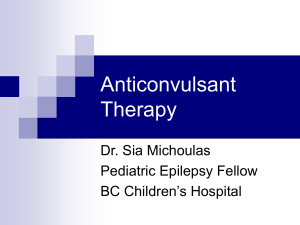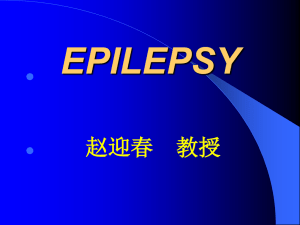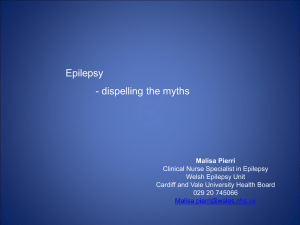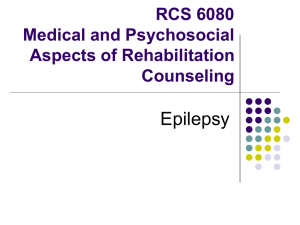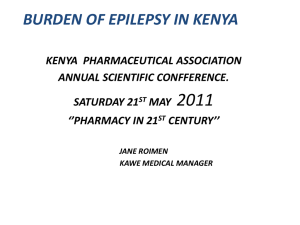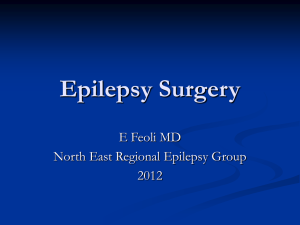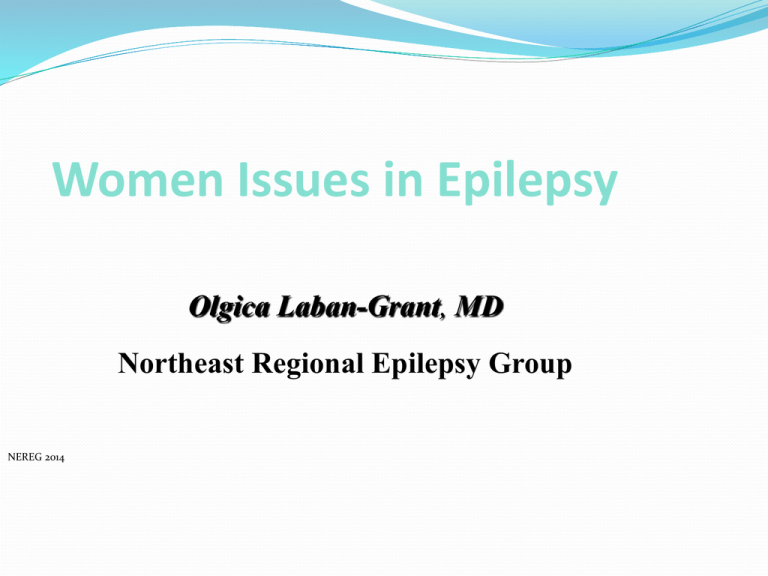
Women Issues in Epilepsy
Olgica Laban-Grant, MD
Northeast Regional Epilepsy Group
NEREG 2014
Epilepsy
women - 41 cases per 100,000
men - 49 cases per 100,000
Gender issues
Men and women have similar
risk for recurrent seizure
likelihood of ultimate remission of epilepsy
Gender issues
Generalized epilepsy is more common in women (58%)
Mostly juvenile absence epilepsy and juvenile myoclonic
epilepsy syndromes
hormones
AED’s
seizures
Major sex steroid hormones in women are estrogen
and progesteron released by ovaries
Hypothalamic-pituitary-gonadal (HPG) axis
HPG axis
Effect of seizures on hormones
seizures
AED’s
hormones
Effect of seizures on hormones
Libido (sexual desire)
Fertility
Menstrual cycle regularity
Onset of menopause
Fertility and Epilepsy
Women with epilepsy have fewer children
Conflicting data regarding fertility
Possible explanations:
Choice (fear of having child with birth defect)
Seizures and/or AED’s may affect reproductive system
Sexual dysfunction
More frequent disorders of menstrual cycle
Polycystic Ovary Syndrome (PCOS)
Menstrual disorders
Menstrual disorders are estimated to occur in 1 of 3
women with epilepsy compared with 1 in 7 in the
general population
One third of menstrual cycles in women with
generalized seizures are anovulatory (ovaries do not
release an egg)
Polycystic Ovary Syndrome (PCOS) and
epilepsy
Syndrome is twice as common in women with epilepsy
10-25% in WWE compared to 7% in general
population
Polycystic Ovary Syndrome (PCOS) and
epilepsy
Multiple cysts in ovaries
High male hormone levels
Excessive facial hair and acne
Other features
Obesity
Irregular menstrual periods
More frequent anovulatory
cycles
Polycystic Ovary Syndrome (PCOS) and
epilepsy
Possible explanations:
Seizure activity in brain alters the production of
hormones
Valproic acid (Depakote) causes features similar to
PCOS
Epilepsy in adolescence
Certain types of epilepsy start at approximate age
(JME) or improve (benign rolandic epilepsy, absence
epilepsy)
Rapid growth may account for poor seizure control
Most seizure disorders are not altered by onset of
puberty
Epilepsy and menopause
Premature menopause is more common
14% of WWE compared to 3.7 % in general population
Menopause occurred on average 3 years earlier
Correlated with estimated life time number of seizures
No influence of AED’s
Effect of hormones on seizures
hormones
AED’s
seizures
Effect of hormones on seizures
Hormones change
the excitability of
the brain and alter
the threshold for
seizures
Effect of hormones on seizure
threshold
PROGESTERONE
Increases
seizure threshold
ESTROGEN
Decreases
seizure threshold
Effect of hormones on frequency of
seizures
PROGESTERONE
Decreases
frequency of
seizures
ESTROGEN
Increases
frequency of
seizures
Hormon sensitive seizures
Catamenial epilepsy
Defined as doubling of frequency of seizures in relation
to menstrual period.
In 1/3 of women with epilepsy there is substantial
relationship between seizures and menstrual cycle.
Hormon sensitive seizures
Catamenial epilepsy
May occur in any type of seizures or epilepsy syndrome
Three major patterns were described
Catamenial epilepsy
Pattern 1
(most common type)
Just before menstruation
(3 days before – until day 3 of menstrual period)
Possibly due to steep decline in progesterone
Catamenial epilepsy
Pattern 2
Just before ovulation
Approximately day 14 of menstrual period
Possibly due to steep elevation in estrogen
Catamenial epilepsy
Pattern 3
In second half of
anovulatory
menstrual cycle
Anovulatory cycles (ovulation does not occur) are
more frequent in women with epilepsy
There is no elevation of progesterone
Catamenial Epilepsy
High levels of estrogen
Low levels of progesterone
Fluid and electrolyte imbalance
Psychological Stress
Decrease in levels of AEDs
Management of Catamenial Seizures
Increase in doses of antiseizure medications during
particular time of menstrual cycle
Intermittent dosing with benzodiazepines
Diamox-limited data to support benefit but low risk
Supplementation with reproductive hormones
Progesterone lozenges in second half of cycle
Adverse effects -sedation, breast tenderness, depression, increased appetite and
weight, breakthrough menstrual bleeding. Progesterone has been implicated in
breast cancer, lipid elevations, and hypercoagulability.
Suppression of menstrual cycle
Oral contraceptive pills
Medroxyprogesterone injections
Catamenial epilepsy and
menopause
Perimenopause
erratic hormone levels
Menopause
low estrogen and
progesterone levels
Effect of AED’s on hormones
AED’s
hormones
seizures
Birth control and epilepsy
Some of the antiseizure medication decrease
efficacy of birth control pills and other hormonal
birth control
This may result in birth control failure and
unplanned pregnancy
Hormonal birth control
and epilepsy
Antiseizure medications that interfere with birth
control:
Carbamazepine (Tegretol)
Phenobarbital
Phenytoin (Dilantin)
Primidone
Rufinamide (Banzel)
Onfi (Clobazam)
Topiramate (Topamax) *higher doses
Oxcarbazepine (Trileptal) *higher doses
Hormonal birth control
and epilepsy
AED’s that have no influence on levels of steroids
Gabapentin (Neurontin)
Lamotrigine (Lamictal)
Levetiracetam (Keppra)
Tiagabine (Gabatril)
Zonisamide (Zonegran)
Pregabalin (Lyrica)
Lacosamide (Vimpat)
Hormonal birth control and epilepsy
Solutions:
Using antiseizure medications that do not interact
with birth control pills
Using alternative birth control methods
Using birth control pills with higher dose of
estrogen (Pitfalls: No proof that higher dose of estrogen is sufficient to prevent
pregnancy)
IUD (intrauterine device)
Two types are available:
Copper IUD
Hormone releasing (Mirena – progesterone) – since
the effect is based on local influence of hormone on
uterus lining it is unlikely to be affected by AED’s
Effect of hormones on AED’s
hormones
AED’s
seizures
Lamotrigine (Lamictal)
Female hormones can decrease levels of
Lamictal (lamotrigine)
Pronounced effect in pregnancy
Epilepsy and Pregnancy
Over 90% of babies born to women with epilepsy will
be healthy.
Although low, birth defect rate is still about twice
(4-7%) of rate in general population (1.6-3.2%).
Most common birth defects
Neural tube defects
Heart abnormalities
Orofacial clefts
Source: CDC
Prenatal Testing
Testing that may be done to detect some of birth defects:
Maternal serum alpha-fetoprotein at 15-22 weeks of
gestation
Level II ultrasound (structural) at 16-20 weeks of gestation
Amniocentesis at 15-20 weeks of pregnancy
Why Prenatal Testing?
Some birth defects require special attention during pregnancy or
during delivery
Some birth defects may require surgery immediately after delivery or
even before delivery
Some other health problems that are more frequent:
Low birth weight/reduced growth potential
Neurodevelopmental problems
Higher risk for epilepsy
Pregnancy
Risk is increased by:
Seizures (especially convulsive seizures)
Antiseizure medications
Genetic predisposition? (mothers who had babies with
birth defect have higher risk in subsequent pregnancies)
Seizures in Pregnancy
Women who have better control of seizures prior to
pregnancy (9 months) usually have fewer seizures
during pregnancy.
Repetitive convulsions are associated with:
Cognitive problems
Small for gestational age
Seizures in Pregnancy
Approximately 35% of women have increase in seizure
frequency
Reasons for increase in seizures
Noncompliance
Nausea/vomiting
Pharmacokinetic changes
Sleep deprivation
Seizures in Pregnancy
Reasons for increase in seizures
Noncompliance
Nausea/vomiting
Pharmacokinetic changes
Sleep deprivation
AED’s during pregnancy
Levels of AED’s drop in second trimester due to:
Increase in drug clearance
Increase in maternal plasma volume
Decreased protein binding
Frequent testing (monthly) and adjustment in dose of
medication may be necessary
AED’s in pregnancy
Risk increased with:
Polypharmacy (two or more AED’s)
Higher levels of medications
Specific AED’s
Not all AED’s are the same
Prevalence of Malformations
lamotrigine (Lamictal®)
carbamazepine (Tegretol®)
phenytoin (Dilantin®)
levetiracetam (Keppra®)
topiramate (Topamax®)
valproate (Depakote®)
phenobarbital (Luminal®)
oxcarbazepine (Trileptal®)
gabapentin (Neurontin®)
zonisamide (Zonegran®)
clonazepam (Klonopin)
2.0%
3.0%
2.9%
2.4%
4.2%
9.3%
5.5%
2.2%
0.7%
0%
3.1%
Unexposed
1.1% 0.37 to 2.6%
NorthAmerican pregnancy registry spring 2012
(1.4 to 2.8%)
(2.1 to 4.2%)
(1.5 to 5.0%)
(1.2 to 4.3%)
(2.4 to 6.8%)
(6.4 to 13.0%)
(2.8 to 9.7%)
(0.6 to 5.5%)
(0.02 to 3.8%)
(0.0 to 3.3%)
(0.4 to 10.8%)
Not all AED’s are the same
Depakote (valproic acid)
Consistently associated with high risk (5-fold higher)
- birth defects
- neurodevelopmental abnormalities (learning
disability, autistic spectrum disorder, ADD/ADHD)
Topamax(topiramate)
- Increased risk for facial clefts (10-fold higher)
Epilepsy & Pregnancy
AED National Pregnancy Registry
Tracks use of AEDs and pregnancy outcomes
All information confidential
Can greatly improve our knowledge
Folic acid
Folic deficiency is associated with increased risk of
neural tube defects.
Folic acid should be initiated before conception and
continued throughout pregnancy
AED’s that are linked to folic acid malabsorption/metabolism are
Phenytoin (Dilantin)
Carbamazepine (Tegretol)
Barbiturates
Valproate (Depakote)
Hemorrhagic disorder of
neonate
AED’s compete with vitamin K across the placenta
Associated with in utero exposure to
Carbamazepine (Tegretol)
Barbiturates (phenobarbital and primidone)
Phenytoin (Dilantin)
Discuss with your Ob need for vitamin K in last month
of pregnancy
Postpartum issues
AED levels may rise – close monitoring of levels is still
necessary
Sleep deprivation and stress may increase frequency of
seizures
Child safety/lifestyle adaptation
Breastfeeding
Benefits of breastfeeding are felt to outweigh
potential risk of continued exposure of
neonate and infant to AEDs (AAN and AAP)
Protein bound drugs have low
concentrations in breast milk
Observe breastfeeding infant for irritability,
poor sleep patterns, or inadequate weight
gain
Epilepsy & Bone health
Altered bone density due to AED’s is associated with:
Phenytoin (dilantin)
Carbamazepine (tegretol)
Barbiturates
Valproate (depakote)
Epilepsy & Bone health
Prevention and therapy >6months on AEDs
- exercise, balanced diet, stop smoking, moderate
alcohol, moderate caffeine
- calcium and vitamin D supplements
- measure Ca, ALP, 25-hydroxy vit D yearly
- Baseline bone density scan
- Referral to endocrinologist if osteopenia/osteoporosis
is diagnosed
THANK YOU!
Northeast Regional Epilepsy Group
epilepsygroup.com
Thank you for coming!
We would like to hear from you
Please submit your surveys
59
Please join us
4:15-4:45
Bergen/Ramapo Room
Safe and effective core exercises
for epilepsy patients
Renata Joy
60

